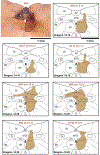Noradrenergic terminal density varies among different groups of hypoglossal premotor neurons
- PMID: 31128245
- PMCID: PMC6717541
- DOI: 10.1016/j.jchemneu.2019.101651
Noradrenergic terminal density varies among different groups of hypoglossal premotor neurons
Abstract
In obstructive sleep apnea (OSA) patients, contraction of the muscles of the tongue is needed to protect the upper airway from collapse. During wakefulness, norepinephrine directly excites motoneurons that innervate the tongue and other upper airway muscles but its excitatory effects decline during sleep, thus contributing to OSA. In addition to motoneurons, NE may regulate activity in premotor pathways but little is known about these upstream effects. To start filling this void, we injected a retrograde tracer (beta-subunit of cholera toxin-CTb; 5-10 nl, 1%) into the hypoglossal (XII) motor nucleus in 7 rats. We then used dual immunohistochemistry and brightfield microscopy to count dopamine beta-hydroxylase (DBH)-positive axon terminals closely apposed to CTb cells located in five anatomically distinct XII premotor regions. In different premotor groups, we found on the average 2.2-4.3 closely apposed DBH terminals per cell, with ˜60% more terminals on XII premotor neurons located in the ventrolateral pontine parabrachial region and ventral medullary gigantocellular region than on XII premotor cells of the rostral or caudal intermediate medullary reticular regions. This difference suggests stronger control by norepinephrine of the interneurons that mediate complex behavioral effects than of those mediating reflexes or respiratory drive to XII motoneurons.
Keywords: Pons; Reticular formation; Sleep apnea; Swallowing; Tongue; motor control.
Copyright © 2019 Elsevier B.V. All rights reserved.
Conflict of interest statement
Figures







Similar articles
-
Neuronal circuitry and synaptic organization of trigeminal proprioceptive afferents mediating tongue movement and jaw-tongue coordination via hypoglossal premotor neurons.Eur J Neurosci. 2006 Jun;23(12):3269-83. doi: 10.1111/j.1460-9568.2006.04858.x. Eur J Neurosci. 2006. PMID: 16820017
-
Sleep-wake control of the upper airway by noradrenergic neurons, with and without intermittent hypoxia.Prog Brain Res. 2014;209:255-74. doi: 10.1016/B978-0-444-63274-6.00013-8. Prog Brain Res. 2014. PMID: 24746052 Free PMC article.
-
Behavior of hypoglossal inspiratory premotor neurons during the carbachol-induced, REM sleep-like suppression of upper airway motoneurons.Exp Brain Res. 2000 Feb;130(4):508-20. doi: 10.1007/s002219900244. Exp Brain Res. 2000. PMID: 10717792
-
Noradrenergic modulation of hypoglossal motoneuron excitability: developmental and putative state-dependent mechanisms.Arch Ital Biol. 2011 Dec 1;149(4):426-53. doi: 10.4449/aib.v149i4.1271. Arch Ital Biol. 2011. PMID: 22205594 Review.
-
Activation of XII motoneurons and premotor neurons during various oropharyngeal behaviors.Respir Physiol Neurobiol. 2005 Jul 28;147(2-3):159-76. doi: 10.1016/j.resp.2005.03.015. Respir Physiol Neurobiol. 2005. PMID: 15919245 Review.
Cited by
-
Deficiency of Biogenic Amines Modulates the Activity of Hypoglossal Nerve in the Reserpine Model of Parkinson's Disease.Cells. 2021 Mar 2;10(3):531. doi: 10.3390/cells10030531. Cells. 2021. PMID: 33801475 Free PMC article.
-
Sex differences in body temperature and neural power spectra in response to repeated restraint stress.Stress. 2024 Jan;27(1):2320780. doi: 10.1080/10253890.2024.2320780. Epub 2024 Feb 28. Stress. 2024. PMID: 38414377 Free PMC article.
References
-
- Agnati LF, Zoli M, Stromberg I, & Fuxe K (1995). Intercellular communication in the brain: wiring versus volume transmission. Neuroscience 69, 711–726. - PubMed
-
- Aldes LD & Boone TB (1985). Organization of projections from the principal sensory trigeminal nucleus to the hypoglossal nucleus in the rat: an experimental light and electron microscopic study with axonal tracer techniques. Exp Brain Res 59, 16–29. - PubMed
-
- Aldes LD, Chapman ME, Chronister RB, & Haycock JW (1992). Sources of noradrenergic afferents to the hypoglossal nucleus in the rat. Brain Res Bull 29, 931–942. - PubMed
-
- Aston-Jones G, Rajkowski J, Kubiak P, Valentino RJ, & Shipley MT (1996). Role of the locus coeruleus in emotional activation. Progr Brain Res 107, 379–402. - PubMed
Publication types
MeSH terms
Grants and funding
LinkOut - more resources
Full Text Sources
Miscellaneous

